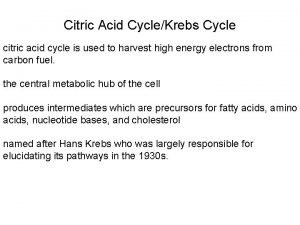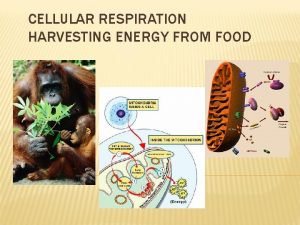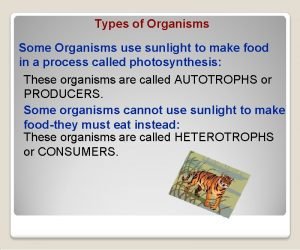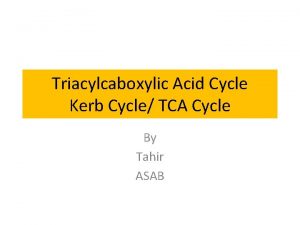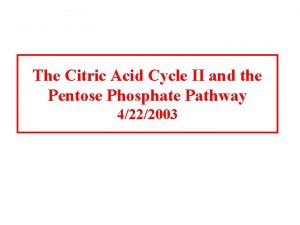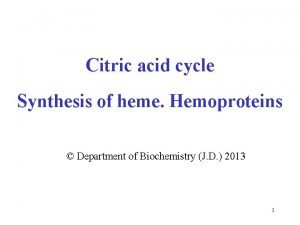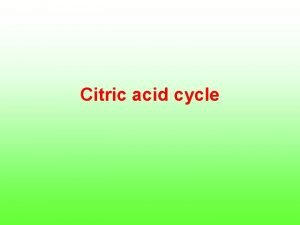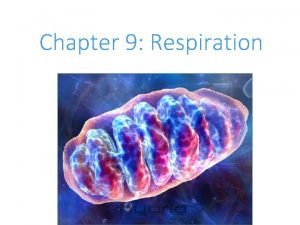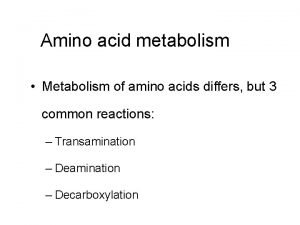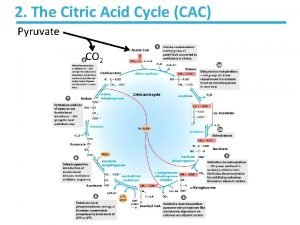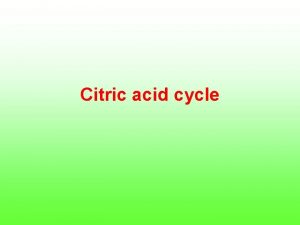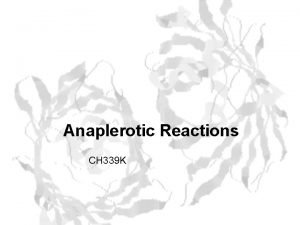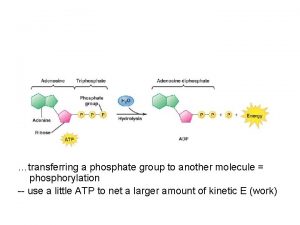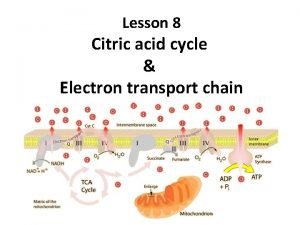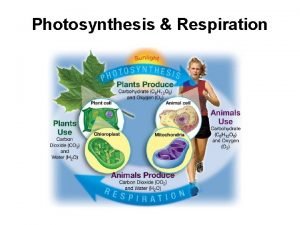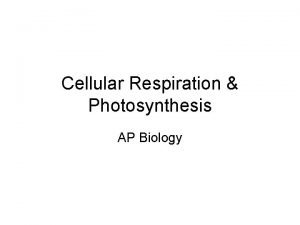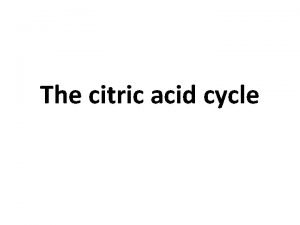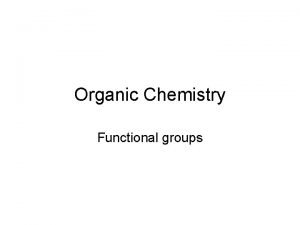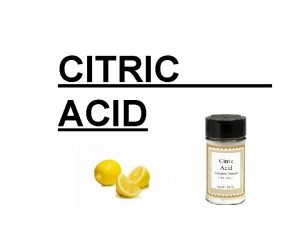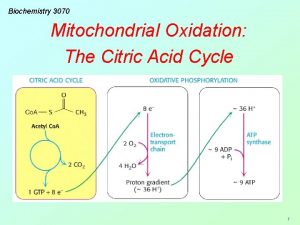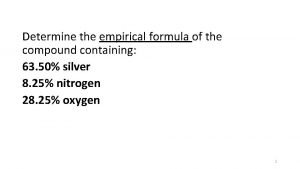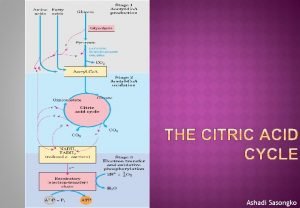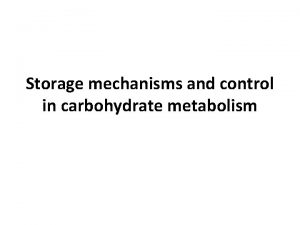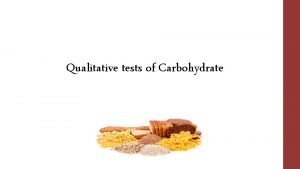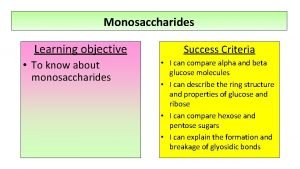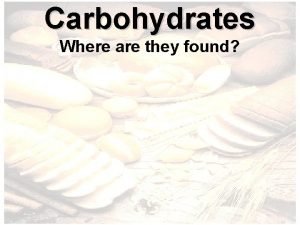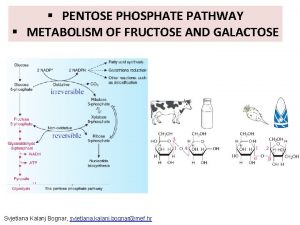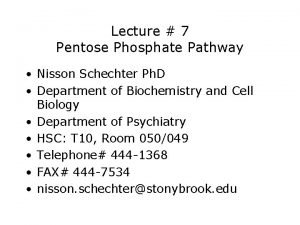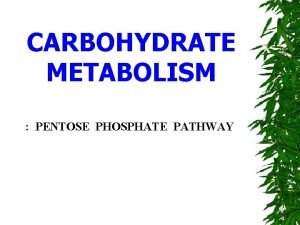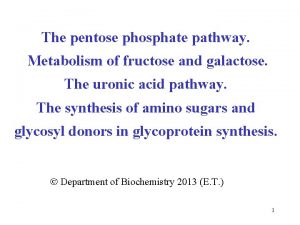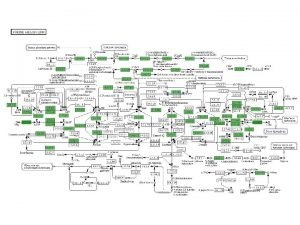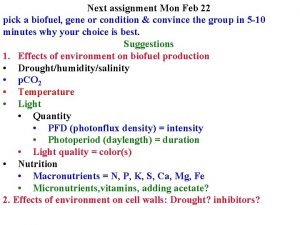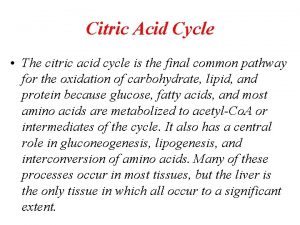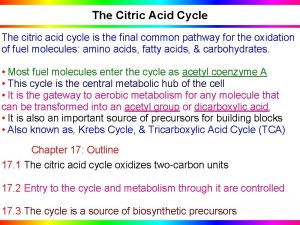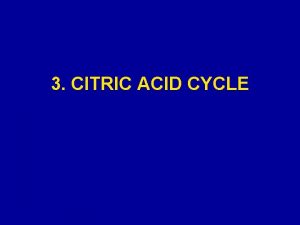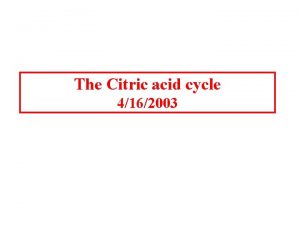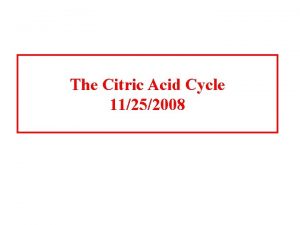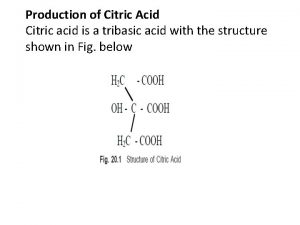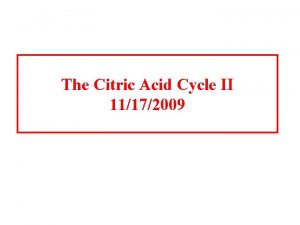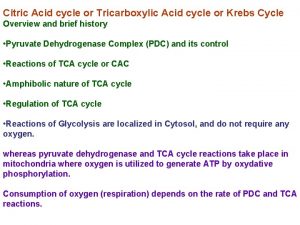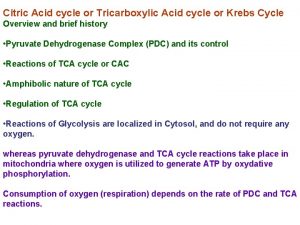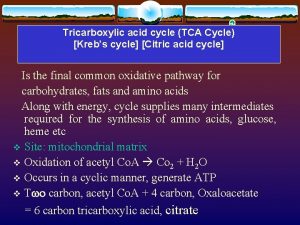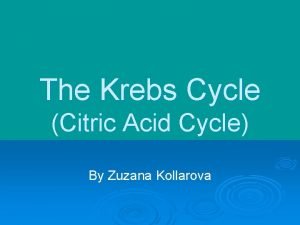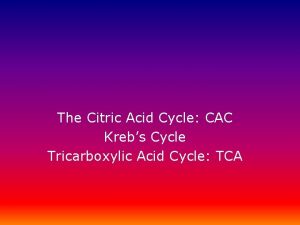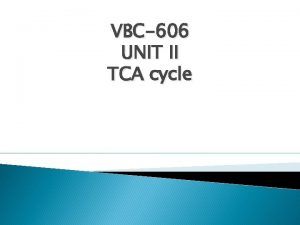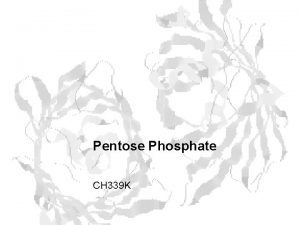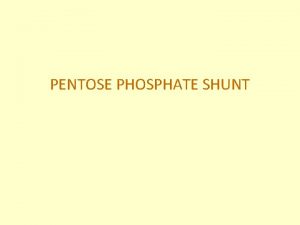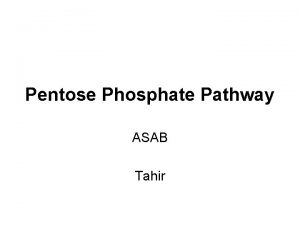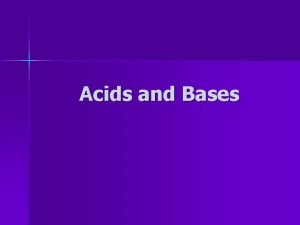The Citric Acid Cycle II and the Pentose






































- Slides: 38

The Citric Acid Cycle II and the Pentose Phosphate Pathway 4/22/2003

The Citric acid cycle Overall reaction 3 NAD+ + FAD + GDP + Pi + acetyl-Co. A 3 NADH + FADH + GTP + Co. A + 2 CO 2

Overview


24 E 2 subunits 24 E 1 orange a and b together 12 E 3 Red EM based image of the core E 2 from yeast pyruvate dh

Domain structure of dihydrolipoyl transacetylase E 2

Acetyl reaction center transferes though the E 2 dihydrolipoyl coenzyme repeats

Citrate Synthase

Induced fit needs binding of oxaloacetate before Acetyl Co. A can bind. Acetyl-Co. A Acetonly Co. A (ground-state analog) Proposed intermediate Carboxymethyl-Co. A (transition state analog)

Aconitase Citrate Cis-Aconitate Isocitrate The double bond is placed on the Pro-R arm

NAD+- Dependent Isocitrate dehydrogenase NAD+ NADH

a-Ketoglutarate dehydrogenase NAD+ CO 2 NADH This enzyme is just like pyruvate dehydrogenase, a multi enzyme complex that is specific for longer Co. A derivatives

Succinyl-Co. A Synthetase or succinate thiokinase

Succinate dehydrogenase + 2 e- + 2 H+ The FAD on the enzyme itself is reduced

Succinate dehydrogenase is the only membrane bound enzyme in the citrate cycle Succ dh--FADH 2 + Ubiquinone or Coenzyme Q Oxidized form Reduced form

Fumarase

Malate dehydrogenase NADH NAD+

Regulation of the citric acid cycle Standard free energy changes in the citric acid cycle Reaction 1 2 3 4 5 6 7 8 Enzyme Citrate synthase Aconitase Isocitrate dh a-KG dh Succinyl-Co. A synthase Succinate dh Fumarase Malate dh DG ' -31. 5 ~5 -21 -33 -20. 1 +6 -3. 4 +29. 7 DG' Negative ~0 ~0

The points of regulation of the cycle

Citric acid cycle intermediates are always in flux

A single molecule of glucose can potentially yield ~38 molecules of ATP

Phosphopentose pathway Produces NADPH and ribose-5 -phosphate NADH and NADPH although chemically similar they are not metabolically exchangeable. Many anabolic pathways require the reducing power of NADPH for synthesis including Fatty acid synthesis and the synthesis of cholesterol. 3 G-6 -P + 6 NADP+ + 3 H 2 O 3 CO 2 + 2 F 6 P + GAP 6 NADPH + 6 H+

The pathway consists of three parts 1. Oxidative reactions: 3 G-6 -P + 6 NADP+ + 3 H 2 O 3 Ribulose-5 -PO 4 6 NADPH + 3 CO 2 + 2. Isomerization and epimerization reactions: 3 Ribulose-5 -PO 4 Ribose -5 -PO 4 + 2 Xylulose-5 -PO 4 3. A series of C-C bond cleavage and formations: Ribose-5 -PO 4 + 2 Xyluose-5 -PO 4 2 F-6 -P + GAP


Glucose-6 phosphate dehydrogenase

Phosphogluconate dehydrogenase

Ribulose-5 -PO 4 isomerase

Two enzymes control the rearrangement of carbon skeletons which result in the production of Glyceraldehyde-3 -phosphate and Fructose-6 -phosphate. Transketolase transfers C 2 units: TPP requiring enzyme like pyruvate dehydrogenase Transaldolase transfers C 3 units: uses a shiffs base with an active lysine group

Transketolase requires TPP

The transition of carbon skeletons in the Phosphopentose pathway

The pentose pathway control The need for NADPH is controlled by glucose dehydrogenase, however, when ribose -5 phosphate is needed (DNA and RNA synthesis) it can be made from the reverse of the transaldolase and transketolase reactions from Fructose-6 -PO 4 and GAP


NADPH is needed for glutathione reductase Reduced glutathione is needed for glutathione peroxidase, which destroy hydrogen peroxide and organic peroxides. This enzyme requires selenium as a cofactor. 2

Glutathione keeps proteins with reduced sulfhydryls SH from oxidizing to R P-SH + P’-SH + O 2 S S R’ P-S-S-P’ + H 2 O P-S-S-P’ G-SH P-SH + G-S-S-P G-SH G-S-S-G + HS-P

Glutathione reductase contains FAD

Reaction of glutathione with peroxides 2 GSH + RA-O-O-H G-S-S-H + ROH + H 2 O A steady supply of glutathione is required for erythrocyte integrity ~ 400, 000 individuals are deficient in glucose dehydrogenase! Without a fully functioning glucose dehydrogenase, glutathione concentrations Hemolytic Anemia can occur if certain drugs are used.

Primaquine, an antimalarial drug is problematic with individuals with glucose dehydrogenase deficiencies Primaquine Similar effects are seen when people eat Fava beans stimulate peroxide formation and the demand for NADPH can not be met. Mature red blood cells lack a nucleus and the ability to make new proteins and membranes. Damage cannot be repaired so cells lyse.

A defective G-6 -P dh confers a selective advantage on individuals living where malaria is endemic. However, only heterozygotic females are resistant to malaria, not males. Plasmodium falciparum can adopt to a cell with decreased levels of phosphopentose products. This enzyme is in the X chromosome and females with two x chromosomes produce half good and half bad blood cells. Plasmodium cannot adapt to the G-6 -P dh deficiency if it is sporadic or random.
 Inputs to the citric acid cycle
Inputs to the citric acid cycle Citric acid cycle and electron transport chain
Citric acid cycle and electron transport chain Where is the citric acid cycle located in the mitochondria
Where is the citric acid cycle located in the mitochondria How is citric acid cycle regulated
How is citric acid cycle regulated Citric acid cycle overall reaction
Citric acid cycle overall reaction Citric acid cycle net equation
Citric acid cycle net equation Citric acid cycle definition
Citric acid cycle definition Where does the citric acid cycle occur
Where does the citric acid cycle occur Amino acid deamination
Amino acid deamination Oxaloacetate
Oxaloacetate Glycolysis overall reaction
Glycolysis overall reaction Citric acid cycle definition
Citric acid cycle definition Citric acid cycle
Citric acid cycle Citric acid cycle
Citric acid cycle Tca cycle and etc
Tca cycle and etc Aerobic respiration nat 5
Aerobic respiration nat 5 Photosynthesis citric acid cycle
Photosynthesis citric acid cycle Photosynthesis citric acid cycle
Photosynthesis citric acid cycle Glyoxylate cycle
Glyoxylate cycle Chemistry
Chemistry Purification of citric acid
Purification of citric acid Oxidation of citric acid
Oxidation of citric acid Citric acid formula
Citric acid formula Diborane empirical formula
Diborane empirical formula Citric acid
Citric acid Citric acid in water
Citric acid in water Chemical property of water
Chemical property of water Gluconeogenesis of amino acids
Gluconeogenesis of amino acids Bial's test positive result
Bial's test positive result Difference between hexose and pentose
Difference between hexose and pentose Difference between hexose and pentose
Difference between hexose and pentose Fructose breakdown pathway
Fructose breakdown pathway Biologically important nucleotides
Biologically important nucleotides Pentose phosphate pathway enzymes
Pentose phosphate pathway enzymes Non-oxidative phase of pentose phosphate pathway
Non-oxidative phase of pentose phosphate pathway 6 phosphogluconate structure
6 phosphogluconate structure Amidophosphoribosyltransferase
Amidophosphoribosyltransferase Pentose phosphate shunt
Pentose phosphate shunt Acid fast vs non acid fast
Acid fast vs non acid fast
